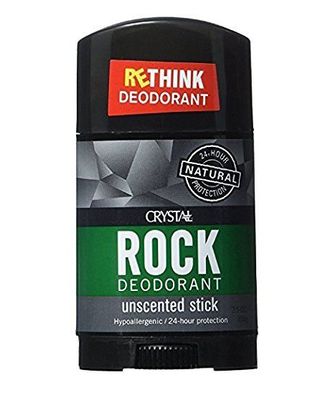What Is Thai Crystal Deodorant Made of
This content is imported from {embed-name}. You may be able to find the same content in another format, or you may be able to find more information, at their web site.
Even though we swipe on a deodorant or antiperspirant daily, it's one product that has a bum rap. Some people allege that the ingredients used in these sweat and stink stoppers are linked to problems like skin irritation and even serious health concerns like cancer.
That's why, driven by the clean beauty trend, people are ditching traditional aluminum-based antiperspirants in favor of crystal deodorants, a natural alternative made of mineral salts.
But is the swap really necessary? We talked to a dermatologist to figure out how crystal deodorants work, if they're any safer than antiperspirant, and what to know before you ditch your tried-and-true formula.
What is crystal deodorant, and how exactly does it work?
"Crystal deodorants use zeolite mineral salts, such as potassium alum or ammonium alum, which may have natural antimicrobial properties," explains Suzanne Friedler, MD, board-certified dermatologist with Advanced Dermatology PC and clinical instructor of dermatology at Mount Sinai Medical Center. "These mineral salts slow down bacterial growth, which is responsible for odor," she says.
The company that started it all, CRYSTAL, says that the inspiration came from a trip to France when the founder discovered that these mineral salts could be used as a top-notch deodorizer. You can buy their deodorants as a stone (yes, you smooth an actual stone onto your armpits) or as a stick, roll-on, or spray formula.
The benefit of a crystal rock deodorant is that it's free of the ingredients that are often blamed for causing irritation, like parabens, phthalates, artificial dyes, and fragrances—a total win for those with sensitive, easily irritated skin.
So is crystal deodorant safer than antiperspirant?
The shift to natural deodorants stems from the fear of ingredients in traditional deodorants and antiperspirants. The problem lies in the parabens or aluminum, which have been blamed for disrupting hormones and thus, have been connected to certain cancers, particularly breast cancer.
The reality is that these claims are unfounded. "While parabens have been studied for a link with breast cancer, the FDA and the National Cancer Institute have stated that they do not believe that antiperspirants or deodorants are related to these cancers," says Dr. Friedler.
Likewise, aluminum has also been linked to Alzheimer's disease, something the Alzheimer's Association calls a myth. "Few [scientists] believe everyday sources of aluminum pose any threat," their website states.
However, if you have ever experienced an underarm rash or stinging after using traditional deodorants and antiperspirants, then crystal deodorants may be worth a shot. (Still, everyone's skin is different, and some users have reported an allergic reaction to crystal deodorants as well, often in the form of a rash.)
"Irritant and allergic reactions are always possible. However, crystal deodorants are considered lower risk because they don't contain the most common allergens," says Dr. Friedler.
Be warned: You may not want to use crystal deodorant if you sweat heavily, since there's a difference between deodorants (which mask odor) and antiperspirants (which actually prevent you from sweating). "Regular antiperspirants contain aluminum chlorohydrate or aluminum zirconium, which act by blocking the eccrine (sweat) glands and preventing wetness," says Dr. Friedler. Crystal deodorants will only help prevent odor; they're not going to keep your armpits dry.
How to use crystal deodorant
Want to give it a whirl yourself? Keep these tips in mind before applying a crystal deodorant:
- Apply to clean, slightly damp skin (ideally right after you bathe) to prevent odor-causing bacteria.
- If you are using a rock (instead of a roll-on or stick) and your skin is not damp, be sure to wet the top of the rock before applying.
- If you apply deodorant to other parts of your body, considering using one just for your armpits and another for other areas to minimize the spread of bacteria.
- Stop using a crystal deodorant if irritation occurs. See your dermatologist if skin issues persist.

Crystal Mineral Unscented Deodorant Roll-On

Crystal Body Deodorant Rock

Crystal Rock Deodorant Unscented Stick
amazon.com

Crystal Mineral Deodorant Spray, Vanilla Jasmine
amazon.com
If you're looking for an aluminum-free formula that's stops stink, is less likely to irritate, but isn't crystal, check out the highly-rated Kopari Deodorant and Native Coconut & Vanilla Deodorant, a paraben- and aluminum-free formula that's newly available at Target. Smell well!
The bottom line: Crystal deodorant can be a good natural alternative if traditional aluminum-based deodorants and antiperspirants irritate your skin. They may only help prevent odor and won't keep your armpits dry if you sweat heavily.
Jessica Migala Jessica Migala is a health writer specializing in general wellness, fitness, nutrition, and skincare, with work published in Women's Health, Glamour, Health, Men's Health, and more.
This content is created and maintained by a third party, and imported onto this page to help users provide their email addresses. You may be able to find more information about this and similar content at piano.io
What Is Thai Crystal Deodorant Made of
Source: https://www.prevention.com/beauty/skin-care/a26040299/crystal-deodorant/
0 Response to "What Is Thai Crystal Deodorant Made of"
Post a Comment